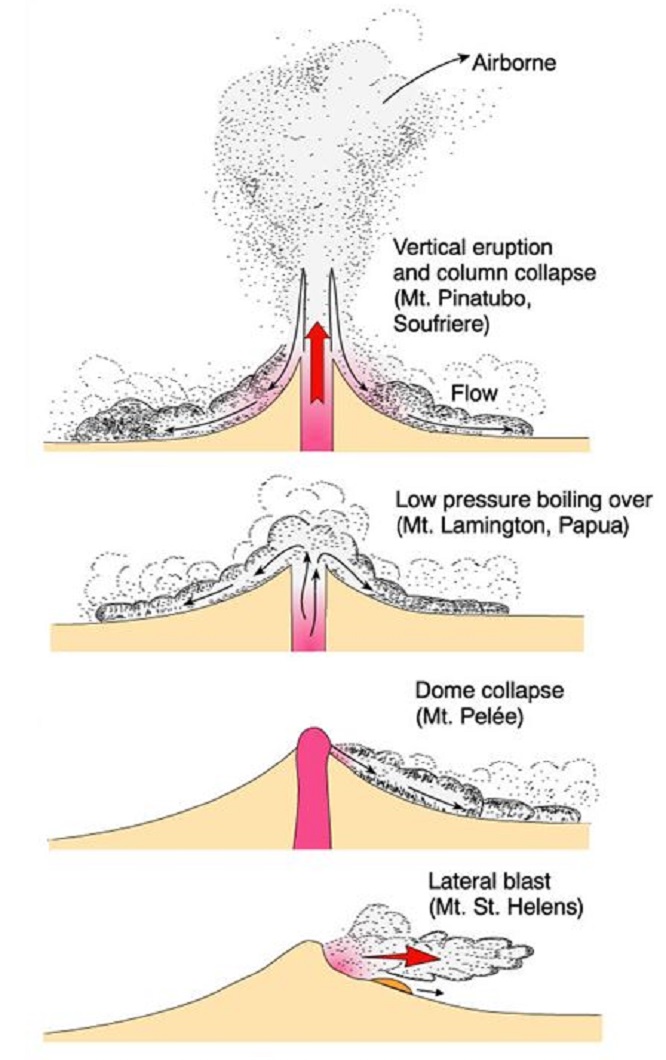Pyroclastic flow
A pyroclastic flow is a fast-moving current of hot gas and rock which reaches speeds moving away from a volcano of up to 700 km/h. The gas can reach temperatures of about 1,000 °C. The word pyroclast is derived from the Greek piros, meaning "fire", and clastos, meaning "broken in pieces". A name for some pyroclastic flows is nuée ardente (French for "burning cloud"); this was first used to describe the disastrous 1902 eruption of Mount Pelée on Martinique. In the dark, these pyroclastic flows glowed red.Pyroclastic flows form due to either collapse of an eruption column or sudden pressure release on volatile-bearing viscous magmas. Column collapse occurs during Plinian or Vulcanian eruptions when parts of the eruption column become unstable owing to increases in the density of the gas-rock mixture. Column collapse tends to occur later in an eruption cycle once the mass flux exiting the vent increases by vent erosion resulting in increases in column density. Once regions of the column become denser than surrounding atmosphere they fall under gravity and obtain a horizontal velocity on contact with the ground. The slope of volcanic edifices tends to direct flows away from vents.
Pressure-release on volatile-bearing viscous magmas (e.g. rhyolite and dacite) can produce pyroclastic flows by sudden exsolution of volatiles and explosive expansion. Pressure release can occur by collapse of a lava dome or a landslide that releases pressure on a cryptodome of magma within the edifice. Such eruptions are known as Pelean activity after the 1902 eruption of Mt Pelee. The pyroclastic flow generated by the 1980 eruption of Mt St Helens was the result of a landslide. High temperature, juvenile-rich, pyroclastic flows originating from lava dome collapse have been termed Nuee Ardentes.
Two end-member types of pyroclastic density current, dilute and concentrated, are recognized from observations of historical eruptions and studies of historic and prehistoric deposits. The dilute endmember is commonly referred to as pyroclastic surge and the concentrated end-member as pyroclastic flow:
Dilute Currents/Surges
These have been observed to travel at speeds of typically tens of meters per second, but blast-like phenomena. These transport systems:
(1) contain less than 0.1 to 1% by volume of solids even close to the ground surface, (2) are density stratified with the highest particle concentrations close to the ground surface, and (3) transport material primarily by turbulent suspension, with a lesser population of coarser clasts moving as a saltating and/or sliding traction carpet. The surge terminates where it becomes positively buoyant with respect to the ambient atmosphere and lifts off to form a buoyant plume.
Concentrated Currents/Flows
These have been observed to travel at a range of speeds similar to that of surges, i.e., from a few meters to several tens of meters per second. These flows:
(1) have solids concentrations of the order of tens of volume percent, (2) have a free surface, above which the solids concentration diminishes sharply, and (3) transport material by a combination of support mechanisms, including particle–particle contact, fluidization support, matrix support, dispersive
Pyroclastic flows are characteristically emplaced at elevated temperature due to the heat contained within juvenile clasts and frictional heating. Pyroclastic flow deposits can be welded or unwelded. High temperature welded flows usually compact under their on weight after emplacement resulting in flattening of pumice fragments to form a eutaxitic texture typical of ignimbrites. The term ignimbrite is also sometimes applied to all pumice flow deposits, whether welded or not, in particular in the US. Pyroclastic flows ingest air and organic matter during their flow. Ingested organics are usually graphitised. Ingested air results in high temperature oxidation.
After emplacement welded pyroclastic flows can continue to flow, in particular if emplaced on a slope. Exsolution of volatiles from juvenile clasts and ingested matter can result in the formation of fumarole pipes.

Types of Pyroclastic flow. Modified from MacDonald (1972).
Soufrière Type: the eruption column can no longer be sustained (due to loss of pressure), so the column collapses forming pyroclastic flows on the flanks of the volcano (St Vincent, 1902). They tend to be cooler than the others.
Pelée Type: a dome of viscous magma (rhyolite, dacite) is blocking the conduit. Eventually it explodes under pressure, blasting pyroclastic material down one of the flanks of the volcano (Mont Pelée, 1902). If it is extremely violent it could produce a lateral blast.
Merapi Type: a dome of viscous magma (dacite,rhyolite) grows in the crater. Eventually it gets so large, it collapses under gravity, producing a pyroclastic flow (Merapi, Indonesia, 1951; Unzen, Japan, 1991; Montserrat, West Indies, 1996).
Bibliography
• Cox et al. (1979): The Interpretation of Igneous Rocks, George Allen and Unwin, London.
• Howie, R. A., Zussman, J., & Deer, W. (1992). An introduction to the rock-forming minerals (p. 696). Longman.
• Le Maitre, R. W., Streckeisen, A., Zanettin, B., Le Bas, M. J., Bonin, B., Bateman, P., & Lameyre, J. (2002). Igneous rocks. A classification and glossary of terms, 2. Cambridge University Press.
• Middlemost, E. A. (1986). Magmas and magmatic rocks: an introduction to igneous petrology.
• Shelley, D. (1993). Igneous and metamorphic rocks under the microscope: classification, textures, microstructures and mineral preferred-orientations.
• Vernon, R. H. & Clarke, G. L. (2008): Principles of Metamorphic Petrology. Cambridge University Press.


.jpg)
.jpg)
.jpg)
.jpg)
.jpg)
.jpg)
.jpg)
.jpg)
.jpg)
.jpg)
.jpg)
.jpg)
.jpg)
.jpg)
.jpg)